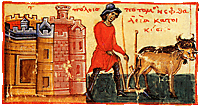 |
|
 |
Paroikoi: categories
 he paroikoi, depending on the way they
he paroikoi, depending on the way they
 cultivated the land and on how much they gave to the owner, fell into two categories: the mortites (morte, "portion") and the hemisiastes (hemisy, "half"). The former cultivated the land by their own means and gave 1/10 of the harvest to the owner, whereas the latter cultivated the land by the means provided by the landowner and gave him 5/10 of the harvest. cultivated the land and on how much they gave to the owner, fell into two categories: the mortites (morte, "portion") and the hemisiastes (hemisy, "half"). The former cultivated the land by their own means and gave 1/10 of the harvest to the owner, whereas the latter cultivated the land by the means provided by the landowner and gave him 5/10 of the harvest.
During the late Byzantine period, the paroikoi were given various additional names depending on the fortune they possessed, that is according to their portion of land, the size of which was determined by the number of animals they used for its cultivation. Thus, the following categories emerged: the
dizeugaratoi, who possessed land that could be ploughed by two pairs of oxen, the zeugaratoi, who possessed land that could be ploughed by one pair of oxen, and the voidatoi, who possessed land that could be ploughed by a single ox. The usual property ranged from about 100 to 200 modioi, that is approximately 20 to 40 hectares of arable land. However, the productivity of the land was also taken into consideration and played an important role in the determination of the size of the holding.
Documents refer to paroikoi who are characterised as
proskathemenoi or proskathemenoi paroikoi. It is very likely, according to scholars, that this was a name for those who had very recently been established and had leased a piece of land before becoming paroikoi. Others believe that the proskathemenoi were those who, for tax reasons, lived outside the village to which they belonged. As for the klerikoparoikoi, also frequently mentioned, these were the paroikoi living on ecclesiastical property.
|